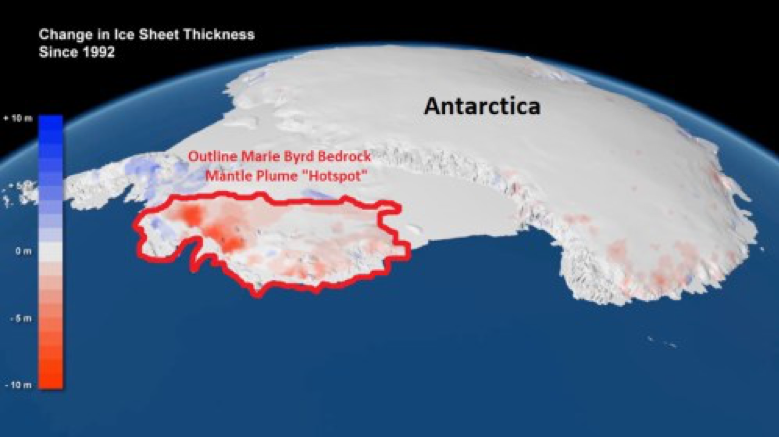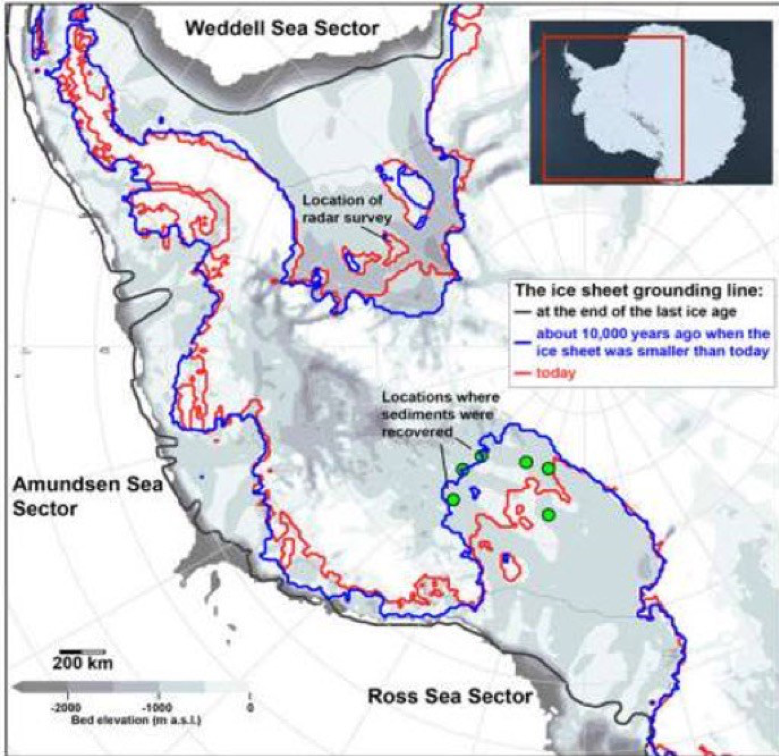Written by James Kamis on June 29, 2018
Three new research studies confirm that geothermal heat flow, not man-made global warming, is the dominant cause of West Antarctic Ice Sheet (WAIS) melting, greatly strengthening the basic premises of Plate Climatology Theory.
Figure 1: Outlined in red is West Antarctica’s subglacial Marie Byrd bedrock mantle plume “hotspot”. Red shading shows West Antarctic Ice Sheet (WAIS) thinning from 1992 to 2017 (credit research study to NASA, mantle plume outline by J. Kamis).
JUNE 22, 2018, RESEARCH STUDY
This study, entitled “Evidence of an active volcanic heat source beneath the Pine Island Glacier“, proves that the Pine Island Glacier of West Antarctica is melting and retreating from geothermal heat from a currently active subglacial volcano, not man-made global warming. See NSF’s press release here.
A previous Climate Change Dispatch (CCD) article posted on December 5, 2014, illustrated the presence of glacial ice melting from bedrock heat flow in the Pine Island Glacial Valley (see here).
Figure 2 is taken from a 2017 CCD article that shows the active geothermal heat sources in the Pine Island Glacial Valley, specifically the Hudson Mountain Volcanic Region, the Mount Takahe Volcanic Region, and a series of linear north- and south-oriented valleys created by deep-earth faults that are part of the giant West Antarctic Rift System.
Figure 2: Bedrock geological setting of the Pine Island Glacier area.
The conclusions of the June 22, 2018, research study, which cites bedrock geothermal heat flow as the root cause of Pine Island Glacier melting, constitute a major setback for the idea that man-made atmospheric global warming is driving this ice melting.
JUNE 21, 2018, RESEARCH STUDY
This research study entitled “Bedrock in West Antarctica rising at a surprisingly rapid rate” shows that the very well-defined Marie Byrd bedrock mantle plume “hotspot” (MB plume) region is rapidly rising and forming an extensive high elevation dome.
Figure 3: Illustration of flowing water under the Antarctic ice sheet. Blue dots indicate lakes, lines show rivers. Marie Byrd Land is part of the bulging “elbow” leading to the Antarctic Peninsula, left-center. Credit: NSF/Zina Deretsky
The Technical University of Demark (TUD) spearheaded the study which concluded that rapid elevation rise of the MB plume region is the result of post-glacial rebound. Post-glacial rebound is a bedrock uplift process that occurs when a thick ice column is greatly reduced or completely removed by melting.
In the case of complete ice column removal, downward pressure on the underlying bedrock is significantly decreased thereby allowing the bedrock to rebound upward, in some cases to its original pre-glaciation elevation position.
There are several problems with invoking post-glacial rebound as the cause of the MB plume region bedrock uplift.
First, by carefully analyzing data from the TUD study it can be shown that the rate of bedrock elevation rise rate in the MB plume region is abnormally high when compared to normal post-glacial rebound rates. Normal rebound rates are 25 millimeters per year.
The MB plume area is rising at 41 millimeters per year, well above the normal rate. TUD scientists said the following about this abnormally high elevation rise rate…“The earth is rising in one part of Antarctica at one of the fastest rates ever recorded…” (see here).
It is here likely that the rapid elevation rise rate of the MB plume region is caused by the uplifting action of geological forces. and not post-glacial rebound.
Second, West Antarctica is still covered by an average 8,200 feet (1.6 miles) of glacial ice. This ice column exerts a downward pressure onto the underlying bedrock of approximately 200 tons per square foot.
Certainly, the TUD research folks have run computer models to explain how post-glacial rebound functions in this thick ice column case. However, utilization of computer modeling by climate scientists has consistently failed for 20 years. Healthy skepticism is proper in this case.
Third, and most telling, the uplifted area matches both the high-heat flow of the MB plume and the WAIS thinning (see Figure 1 atop this article). This strongly indicates a cause and effect relationship between elevation rise and MB plume activity.
The upward forces and surface lava emissions from mantle plumes are capable of rapidly uplifting enormous geographic regions. You may have heard of one, it’s called Iceland.
The Iceland/Greenland mantle plume is actively uplifting and adding layers of lava flows to Iceland thereby increasing the elevation of this geologically active island.
It is here contended that the high elevation rise rate of West Antarctica’s MB plume region is the result of geothermal bottom melting of the ice column and upward bulging of the bedrock related to the MB plume and not post-glacial rebound.
Additional information concerning the geologically active Marie Byrd bedrock mantle plume “hotspot” and the giant deep-earth fault that fuels this plume and over a 100 subglacial volcanoes can be found at these previous Climate Change Dispatch articles (see here, here, here, here, and here).
JUNE 13, 2018, RESEARCH STUDY
This study, entitled “New study suggests surprising wrinkle in the history of West Antarctic Ice Sheet”, proves that the WAIS significantly melted and retreated 10,000 years ago, then quickly recovered to its full extent (see Figure 4).
An event that obviously pre-dates human involvement. Additionally, neither this study or other previous studies have found evidence that the giant East Antarctic Ice Sheet (EAIS) retreated during the same ancient time frame.
This information strongly indicates that ancient ice melting of the WAIS is almost certainly related to underlying bedrock geothermal heat flow from geographically specific geological features and not worldwide atmospheric global warming.
It’s difficult, if not impossible, for atmospheric warming to significantly melt the WAIS while not melting the adjacent EAIS.
Active geological features 10,000 years ago include the 5,300-mile-long deep-earth West Antarctic Rift System, which was formed approximately 150 million years ago and is still active today, and the previously mentioned MB plume, which is likely part of Pacific Ring of Fire (see here).
Figure 4: Map illustrating the 10,000-year-old West Antarctic Ice Sheet retreat and its current position (credit NIU et al.).
SUMMARY
By combining the data and conclusions of three brand new research studies with very telling older research studies and previous CCD articles, it becomes very clear that melting of West Antarctica’s Ice Sheet is the result of bedrock geothermal heat flow, not atmospheric global warming.
Climate scientists strongly advocating the theory of the global warming to explain the WAIS melting should broaden their research and analyzation process to include the impact of geological forces, like subglacial volcanoes.
It’s time for all of us to help these well-intentioned scientists achieve this goal.





